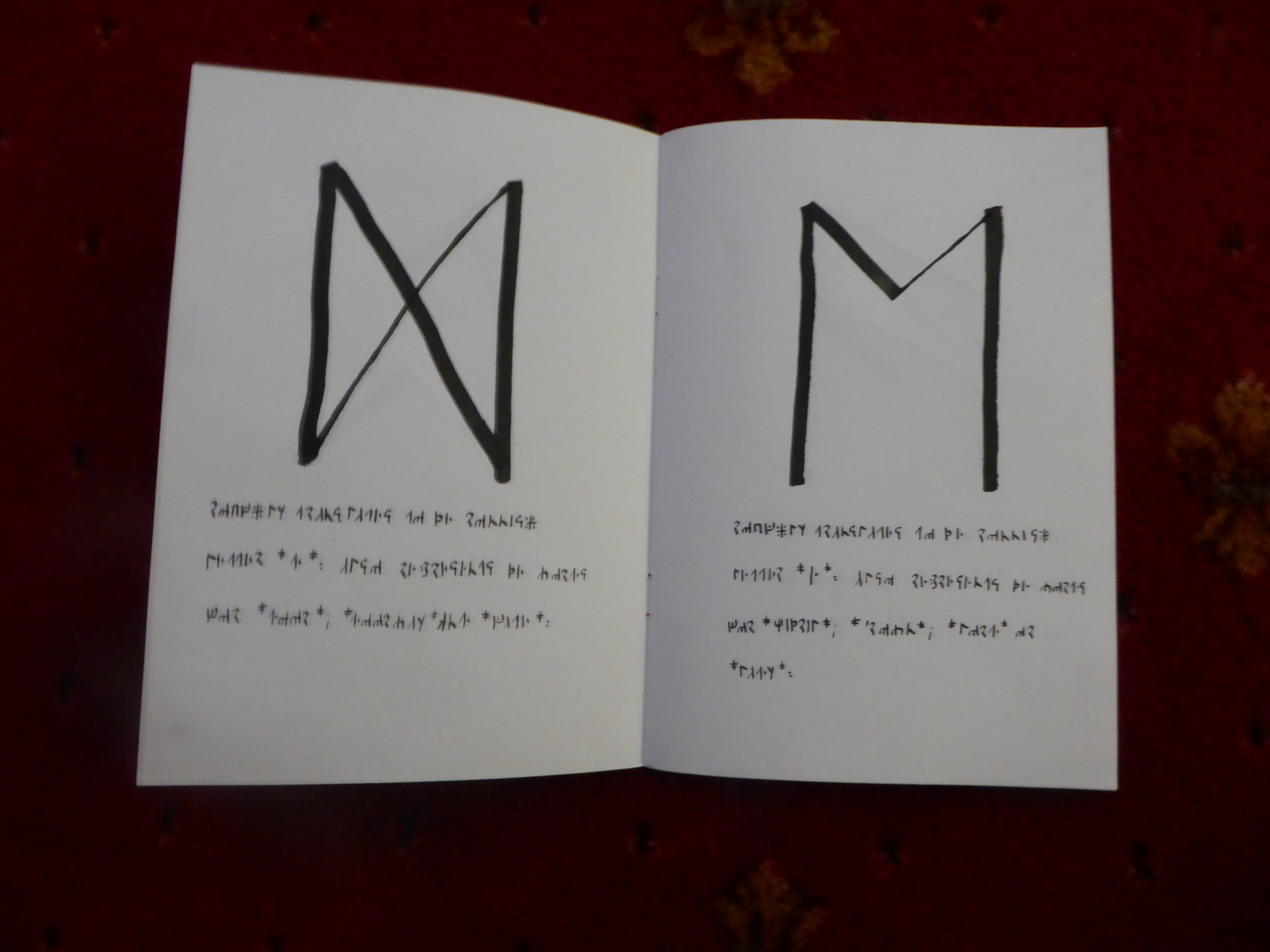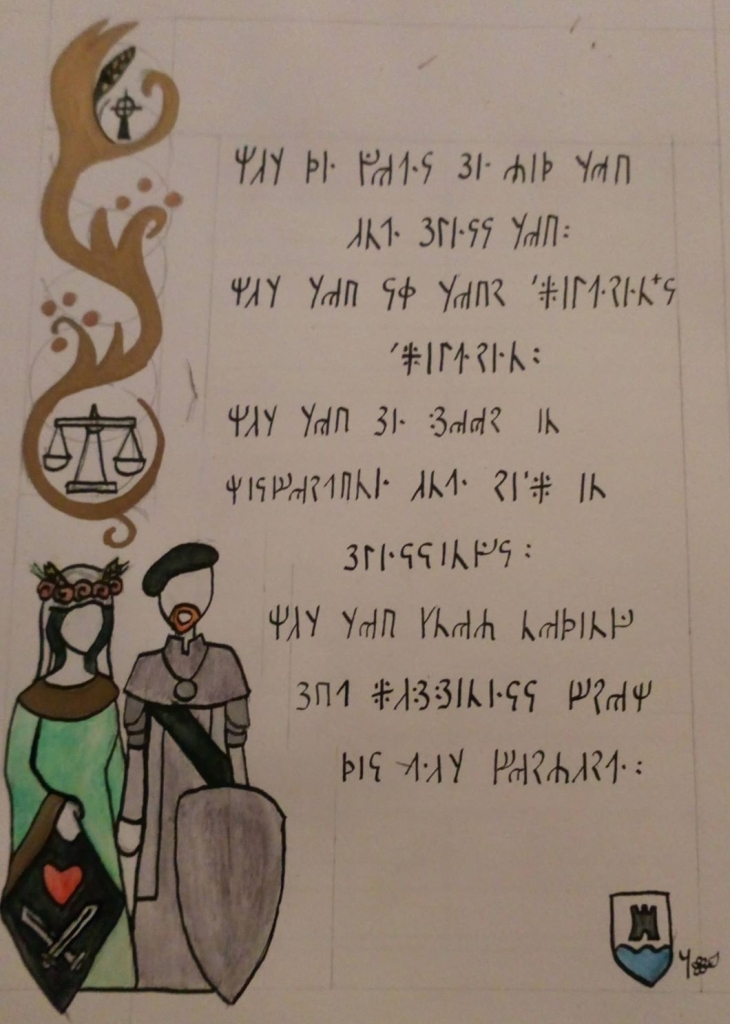Over the last few years I have expanded this blog out from simple LARP kit sewing tutorials and the log of the Ithronian (mis)Adventures into more personal projects; and whilst I have written about calligraphy in the past and shared links to blogs that I follow or use for inspiration, I have rarely shared any of my own work.
But today I would like to share with you some ink, paint and paper projects I have worked on and are especially proud of. I hope that you enjoy a quick peek into my more unusual LARP projects.
Until fairly recently my calligraphy attempts were using a dip ink pen badly to do ‘olde-worlde’ writing for craft projects at school. I remember writing an imagined account from the First World War on tea/coffee stained paper using grey ink and a dip ink pen from a kit that must have come from the Royal Armouries or some other historical venue for an English assignment, and I’m sure I butchered a hair ribbon to make a wax seal stamp on a ‘document’ for History homework once or twice (I’m sure tea stained projects are a mandatory part of school homework). Ah memories. The reason I recall the English homework incident is because I was asked if I had photocopied it from somewhere else because the grey ink had faded – I think I was upset and indignant in my response as only a teenager who has worked really hard on making a craft piece of homework can be. But beside an indignant teenage me putting in unnecessary effort over homework, I didn’t really do much with the dip ink pen. At least not until I took up LARPing and packaged up my art supplies from my parents’ house to take home with me.
It wasn’t until I was reading around some SCA scribal blogs like Ian the Green and the Pensive Pen; and stumbled across The Postmans Knock that I thought I might have a go at doing something with my assorted collection of dip ink nibs, watercolour pencils and paints and other abandoned art supplies. I also had a fountain pen ‘beginners’ calligraphy set which included instructions on shaping the letters that had been a present, and a beautiful wooden boxed calligraphy ink set from my OH for an anniversary, and … and …
Well, in short I had a lot of supplies just begging to be used.
I started off by using the fountain pen set to make gift tags for presents (which has now become somewhat of a Christmas tradition as I’ve noticed some of the family using them for bookmarks) and doing pretty in-character letters with poncey headed notepaper and the occasional doodle. But having read loads of blogposts on beautiful artwork, medieval inspired scrolls and watercolour calligraphy, I decided it was time to take the leap and attempt my own calligraphy projects. It is only fitting that since most of my arts and crafts supports my LARP hobby, that I would make something for LARP.
Place cards
Adding a small detail to the dinner table at the 1930s game I crew is something I have come to enjoy. Sometimes when I’ve not been feeling too well I’ve been able to take a rest break and do something productive, but not too energetic, to contribute to the game.

A banner
For Newcastlefest I got to help with set dressing and created a banner for the main shrine area. This was made using artists canvas and acrylic paint, with a channel for the pole sewn in using a sewing machine – in a similar manner to my reuseable scrolls.

The Dwarven Dictionary
I also handwrote the dwarven rune dictionary for Newcastlefest using a bamboo and standard dip ink pens. I took a simple Hobbycraft sketchbook apart, made a template for the runes and page layouts, and planned out the content of the book before I started writing. The front cover was decorated with a visage of the dwarven version of Rolbor (God of Knowledge and Trade) using acrylic paint, ink and metallic sharpie, and the whole book stitched back together using crochet wool.



The reaction from the players was priceless and well worth the effort. I actually found the whole thing quite relaxing as I spaced it out over several sessions so I could let the ink dry.
A noble’s blessing
Having made scrolls in the past with acrylic paint and sharpie pen, my first major calligraphy project was a gift for a good friend of mine for the occasion of his character’s in-character marriage. I could have given him something ornate in-character and told him to use his imagination – “it’s a gorgeous inked manuscript decorated with gold leaf, honest!”. No, I wanted to actually give him something to keep and enjoy. So I got out the drawing pad, searched the internet for a suitably inoffensive medieval / Celtic blessings that I could comfortably adapt to the game setting, and got to it.

I used a bronze / gold metallic sharpie for the bits I would like to gild if I had been doing a ‘proper’ scroll, but apart from that I used watercolour pencils and my usual black ink for the details.
Noble Heraldry
I have always had an interest in heraldry (and knights and castles and other suitably historical / fantasy based things) and at one time had a huge (and I do mean HUGE) poster of heraldry terms and shields on my wall. This has morphed into an interest in in-character heraldries in game. Another player made the suggestion about creating an in-character book of heraldry for the feudal knights and after some umm-ing and aah-ing I eventually got on board. This project is still a work in progress, but I would like to think that this project might outlive my character and continue on.
But for now, it’s a very merry project to work on.

To make this project more accessible I have written the entries in English using the uncial hand and two sizes of my standard dip pen nibs. Because this page will eventually be photocopied onto cream card to protect the originals from the inevitable damage of wet and mud of a campaign field, I am using calligraphy felt tip pens for the heraldry. I’ve found these more practical to use when photocopying than calligraphy inks, water colours or acrylic paints.
I’ve made a pair of templates for the pages with ruled lines and a grid layout behind the shields to help with positioning features likes the stripes or chevrons found in some heraldry, with space for the coronets or helmets on top. The reverse of the page is done on a second sheet, with the pair eventually photocopied onto a single piece of card which is then cut and prepared to be included in the binding. I’ll likely do a more in depth entry on this book once it’s ‘done’.
All work shown with permission from recipients.
Please leave a reply …